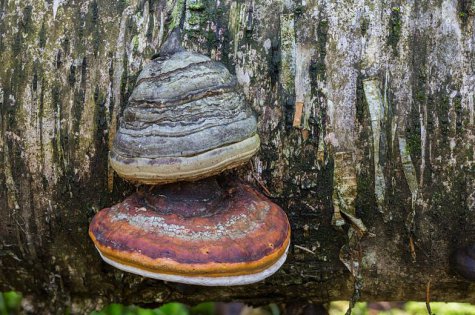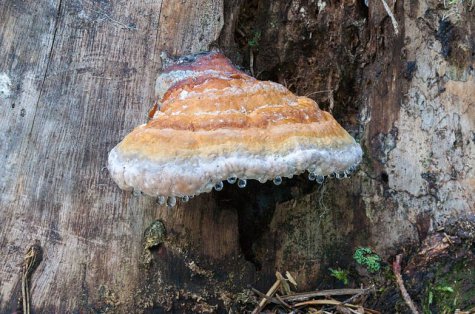Something to see in an autumn forest
Photos Arne Ader
Translation Liis
Tinder fungus (Fomes fomentarius) and red-belted bracket
Sometimes old red-belted bracket fungi can become quite like tinder brackets.
Red-belted bracket fungus; Red belted polyporeKännupess Fomitopsis pinicola
The forest turns ever more sparse, vegetation also becomes poorer, but we can also see new things on regular forest hikes.
In our forests we often notice a perennial tree fungus – the red belted bracket fungus or red belted polypore. It grows on pines, spruces, birches or on other deciduous trees too, as well as wood stacks. The fruiting body of a mature red-belted bracket is often brightly coloured in places, and at the edge of the body is a reddish-orange band.
The otherwise ornamental red-belted bracket causes brown rot in wood. What then does wood damaged by brown rot look like? The decaying wood turns brown and splits easily into cube-shaped bits. Maybe this is familiar?
The brown residue, mainly consisting of lignin or humus, is extremely persistent, remaining in soil for hundreds, not to say thousands of years. Because of this these residual products are considered to be important soil structure elements which increase soil aeration and its water holding capacity and favour the formation of ectomycorrhiza.
Organsims causing brown rot are rather few in our nature; the dry rot fungus (Serpula lacrymans) may be mentioned as a relative of the red belted bracket fungus.
Gutation on red-belted bracket fungus
What does gutation mean? It is a secretion of fluid drops from growing organisms that generally takes place through openings or stomata for liquid. In Latin gutta means drop. Gutation usually occurs between late night and early morning, in periods of very high humidity, and evaporates during the next day, influenced by temperature rise or decrease of air humidity.
The gutation fluid from plants is different from early morning dew. Moisture in air condenses as dew for instance on car tops (a phenomenon familiar to all) because the temperature of the metal roof has become lower during the night than the morning air temperature.










